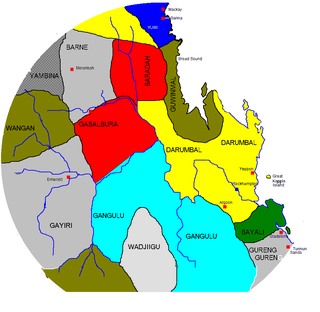Related Research Articles
Ngardi, also spelt Ngarti or Ngardilj, is an Australian Aboriginal language that is considered moribund. It was previously thought to be an alternative name for the Bunara language, but these are now classified as separate languages. It was/is spoken by the Ngarti people of the Northern Territory and northern Western Australia.

The Paakantyi language, also spelt Paakantji, Barkindji, Barkandji, and Baagandji, and is also known as the Darling language, is a nearly extinct Australian Aboriginal language spoken along the Darling River in New South Wales from the present-day Queensland border to Bourke, then along the river to Wentworth. It includes much of the backcountry around the Paroo River, plus an area along Coopers Creek into Queensland and also through the Broken Hill district.

The Gangulu people, also written Kangulu, Kaangooloo, Ghungalu and other variations, are an Aboriginal Australian people from the Mount Morgan area in Queensland, Australia.
Kukatj, also rendered Gugadj, is an extinct Paman language of the Cape York Peninsula, Queensland, Australia. The name Kalibamu has also been assigned to it, although this may be a separate dialect. It is spoken by the Kukatj people. A single speaker was last recorded in 1975.
Umpithamu, also spelt Umbindhamu, is an Australian Aboriginal language of the Cape York Peninsula, Queensland, Australia.

Barunggam (Murrumningama) is an extinct Pama-Nyungan Aboriginal language spoken by the Barunggam people of Queensland in Australia. The Barunggam language shared many words with the neighboring languages, including Jarowair to the east, Wakka Wakka to the north and Mandandanji to the west. Kite and Wurm describe Barunggam as a dialect of Wakka Wakka.
Wanggamala, also spelt Wanggamanha, Wangkamahdla, Wangkamadla, Wangkamanha, Wangkamana, Wonkamala, Wongkamala, Wonkamudla, and other variants, is an extinct Australian Aboriginal language of the Pama–Nyungan family, previously spoken in the Northern Territory around Hay River and to the south of the Andegerebinha-speaking area.
Mayi-Kutuna, also spelt Mayaguduna, Maikudunu and other variants, is an extinct Mayabic language once spoken by the Mayi-Kutuna, an Aboriginal Australian people of the present-day Cape York Peninsula in northern Queensland, Australia.
Biri, also known as Biria, Birri Gubba, Birigaba, Wiri, Perembba and other variants, is an Australian Aboriginal language of the Mackay area of Queensland spoken by the Birri Gubba people. There are at least eight languages regarded as dialects of Biri, and two which are related but whose status is not yet fully determined. All are covered in this article.
Waanyi, also spelt Wanyi, Wanji or Waanji, is an endangered Australian Aboriginal language spoken by the Waanyi people of the lower gulf area of Northern Queensland, Australia. Although earlier thought to be extinct, as of the 2016 Australian census there were 16 speakers of the language. This was down from the recorded peak of 40 in the 2011 Australian census.
The Garandi language, also rendered Karundi, Garandji, Karrandee and other variants, is thought to be an extinct Paman language of the Cape York Peninsula, Queensland, Australia. It also known as Kotanda and Kutanda, names which are primarily assigned to Gkuthaarn (Khutant), and some sources view it as a dialect of this language. AIATSIS (AUSTLANG) assigns a separate code to this language (G32), but it is status is "Potential data".
The Gia people, also known as Giya, Kia, Bumbarra, and variants, are an Aboriginal Australian people of the state of Queensland. Little is known of them.
The Wanggamala people, also spelt Wangkamahdla, Wangkamadla, Wangkamanha, Wangkamana, Wonkamala, Wongkamala, Wonkamudla, and other variants, are an Aboriginal Australian people of the Northern Territory and Queensland.
The Kareldi was a name assigned by Norman Tindale to Aboriginal Australian peoples of the state of Queensland. There were two groups that went by this name, the Garandi (Karandi), after the Garandi language, and the Gkuthaarn, after the Gkuthaarn language. It is not clear if they constituted a single people, but it appears that there were two dialects in the same area.
The Marrago were an Aboriginal Australian people of the state of the Cape York Peninsula in northern Queensland. They may have been a subgroup of the Mayi-Kutuna.
The Wakaman people, also spelt Wagaman, are an Aboriginal Australian people of the state of Queensland. According to some authorities, they may be interchangeable with the group identified by ethnographers as the Agwamin.
The Yangga, also spelt Jangga, are an Aboriginal Australian people of the state of Queensland. They are not to be confused with the Yanga people.

The Yambina were an Aboriginal Australian people of the state of Queensland, whose traditional lands lie inland (westwards) some distance from Mackay.
The Yangkaal, also spelt Yanggal, are an Aboriginal Australian people of area of the Gulf of Carpentaria in the state of Queensland.
The Yukulta people, also spelt Jokula, Jukula, and other variants, and also known as Ganggalidda or Gangalidda, are an Aboriginal Australian people of the state of Queensland.
References
- ↑ G31 Gkuthaarn at the Australian Indigenous Languages Database, Australian Institute of Aboriginal and Torres Strait Islander Studies
- 1 2 3 4 5 G31 Ghutkaarn at the Australian Indigenous Languages Database, Australian Institute of Aboriginal and Torres Strait Islander Studies
- ↑ "Gkuthaarn Kukatj Indigenous Land & Sea Ranger". Carpentaria Land Council Aboriginal Corporation. September 2020. Retrieved 13 October 2020.
- ↑ Barry, Derek (30 September 2020). "Native title win for Gkuthaarn and Kukatj people". The North West Star. Retrieved 13 October 2020.
- ↑ G32 Garandi at the Australian Indigenous Languages Database, Australian Institute of Aboriginal and Torres Strait Islander Studies
- ↑ Armit, W. E. (1886). "Mouth of the Norman" (PDF). In Curr, Edward Micklethwaite (ed.). The Australian race: its origin, languages, customs, place of landing in Australia and the routes by which it spread itself over the continent. Vol. 2. Melbourne: J. Ferres. pp. 306–309.